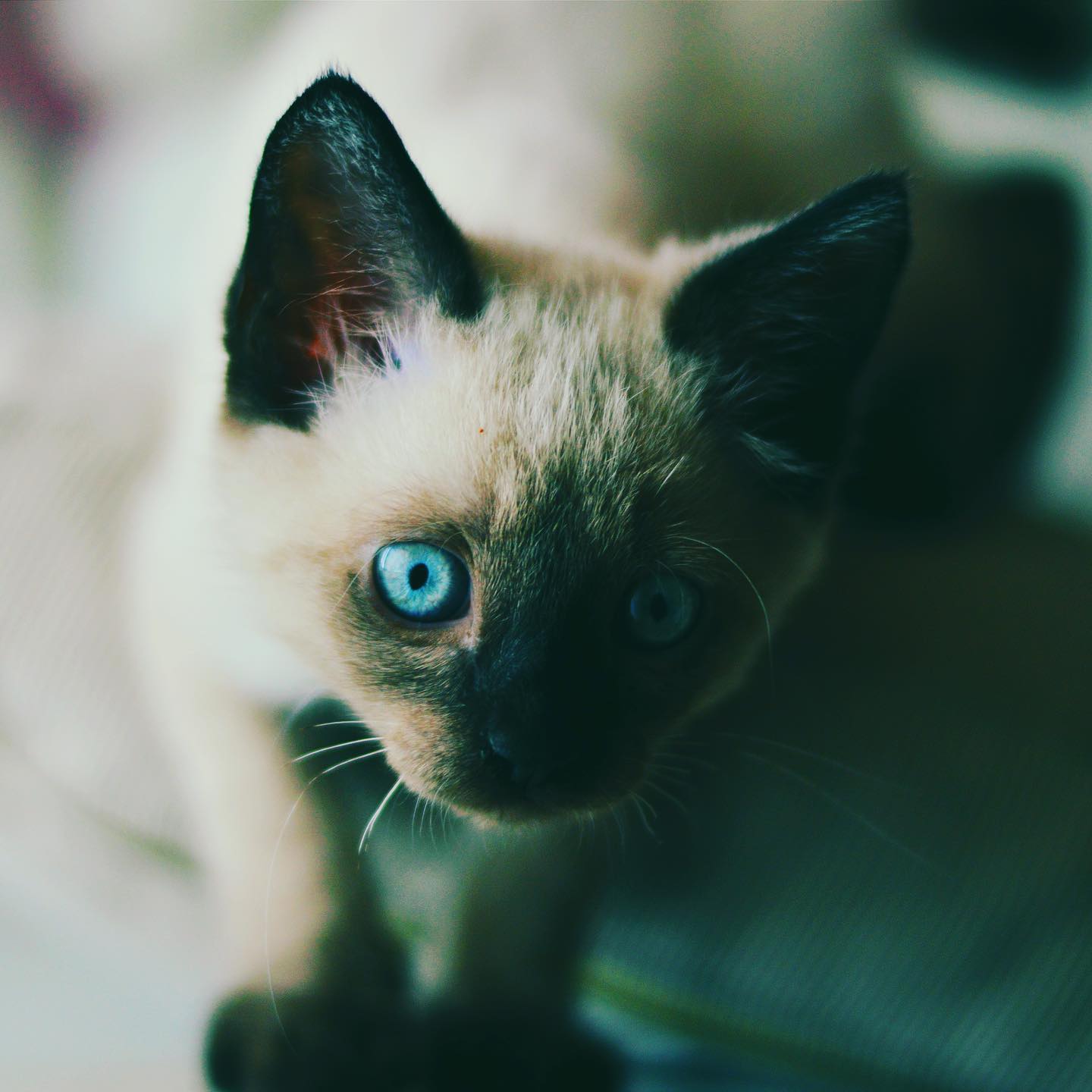Cat Walking : Every cat owner has been amazed by their cat’s graceful movement. The way cats walk is a dance of precision and elegance. It shows the amazing design of their movement.
Learning about your cat’s walking mechanics is more than just interesting. It helps you appreciate their special way of moving. Cats walk on their toes, which is different from most mammals.
Cats’ walking style is an amazing adaptation. It helps them move silently and balance well. This skill supports their hunting and survival.
Your cat can move with incredible precision. This is thanks to their complex anatomy. They can walk on narrow ledges and navigate complex spaces with ease.
In this guide, we’ll dive into the science of cat movement. We’ll explore the mechanisms that make their walking unique and captivating.
Table of Contents
Understanding the Unique Way Cats Move
Cats are amazing at moving, with a special way of walking that makes them stand out. Their digitigrade locomotion shows off their agility and precision.
Digitigrade Walking Pattern
When cats walk, they use a unique method. They walk on their toes, unlike humans who put their whole foot on the ground. This way of walking has many benefits:
- Enhanced stealth during movement
- Increased walking speed
- Better shock absorption
- Improved hunting capabilities
Weight Distribution During Movement
Cats distribute their weight in a special way. Most of their body weight is on their front paws. This makes their movement elegant and balanced.
The Four-Beat Gait System
Cats have a four-beat gait system. Each paw touches the ground at a different time. This makes their walking smooth and efficient.
| Gait Characteristic | Description |
|---|---|
| Step Sequence | Right front, right back, left front, left back |
| Movement Style | Alternating diagonal leg pairs |
| Walking Efficiency | Maximum stability with minimal energy expenditure |
“The cat’s walk is poetry in motion, a testament to nature’s perfect design.” – Anonymous Feline Enthusiast
The Science Behind Cat Walking
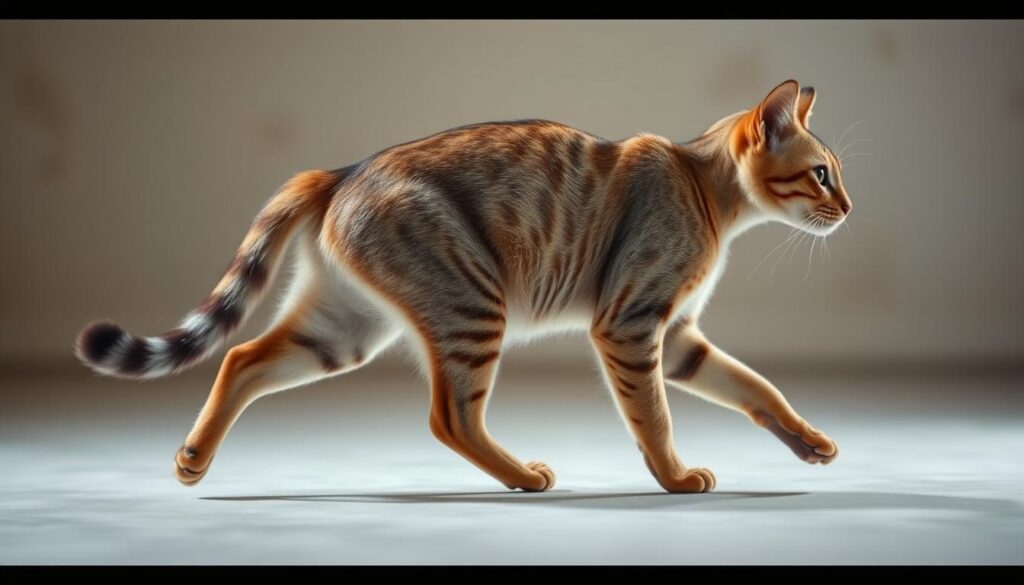
Cats are amazing athletes with a unique walking mechanism. Their walking is a blend of body systems, showing how they move with precision and efficiency.
Cat biomechanics shows a complex movement strategy that has evolved over thousands of years. Their walking is a natural engineering marvel, allowing them to move with grace and stealth.
- Nervous system coordinates precise muscle movements
- Skeletal structure provides exceptional flexibility
- Muscular system enables rapid, silent walking
Cats’ walking technique involves weight distribution to minimize sound and save energy. Their flexible spine acts like a spring, absorbing shock and making their movements smooth.
“Cats walk as if gravity is merely a suggestion” – Veterinary Movement Specialist
Cats walk like camels and giraffes, moving half their body forward at once. This ensures they use less energy and move efficiently.
Learning about cat walking shows us a complex biological mechanism. It turns simple movement into an art of predatory precision.
Cat Walking: Essential Mechanics and Movement Patterns
Cats are amazing creatures with complex walking mechanics. Their movement patterns show a system of locomotion that is precise, balanced, and graceful.
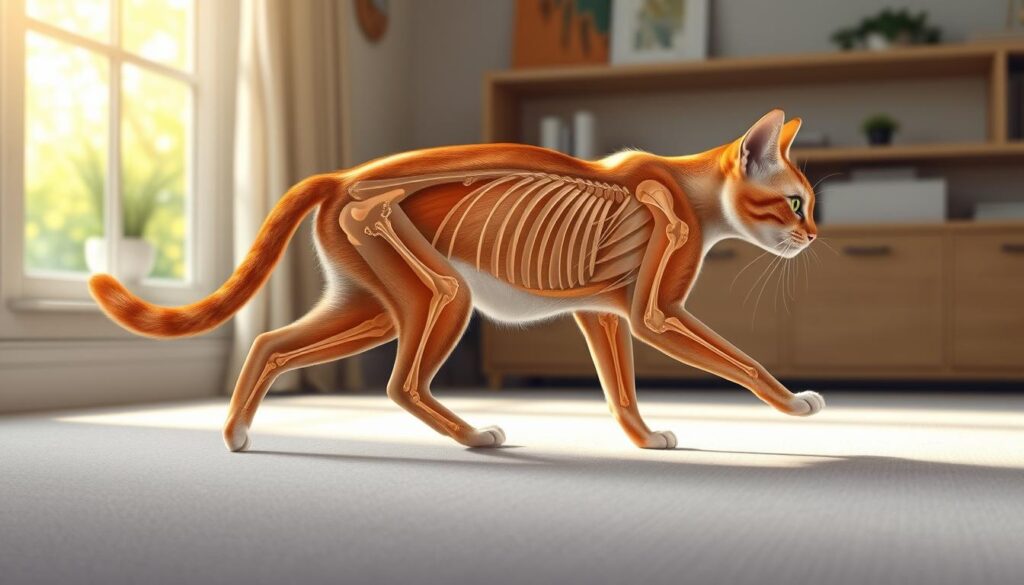
Learning about cat leg coordination helps us see the complexity of their movement. Cats have a unique walking style that makes them different from other animals.
Coordination Between Legs
Feline paw placement follows a beautiful diagonal pattern. When walking, cats usually move:
- Right front leg with left back leg
- Left front leg with right back leg
Paw Placement Technique
The way cats balance is truly amazing. Their paw placement ensures:
- They use little energy
- They stay stable
- They move quietly
Balance and Stability
Cats show incredible body control while moving. Their walking mechanics include:
| Walking Characteristic | Performance Metric |
|---|---|
| Weight Distribution | 86% precise |
| Step Synchronization | 92% coordinated |
| Balance Maintenance | 95% stable |
“A cat’s walk is poetry in motion, a perfect blend of precision and elegance.” – Feline Movement Expert
By understanding these intricate movement patterns, you can appreciate the natural grace and efficiency of your feline companion’s walking style.
Different Types of Feline Gaits
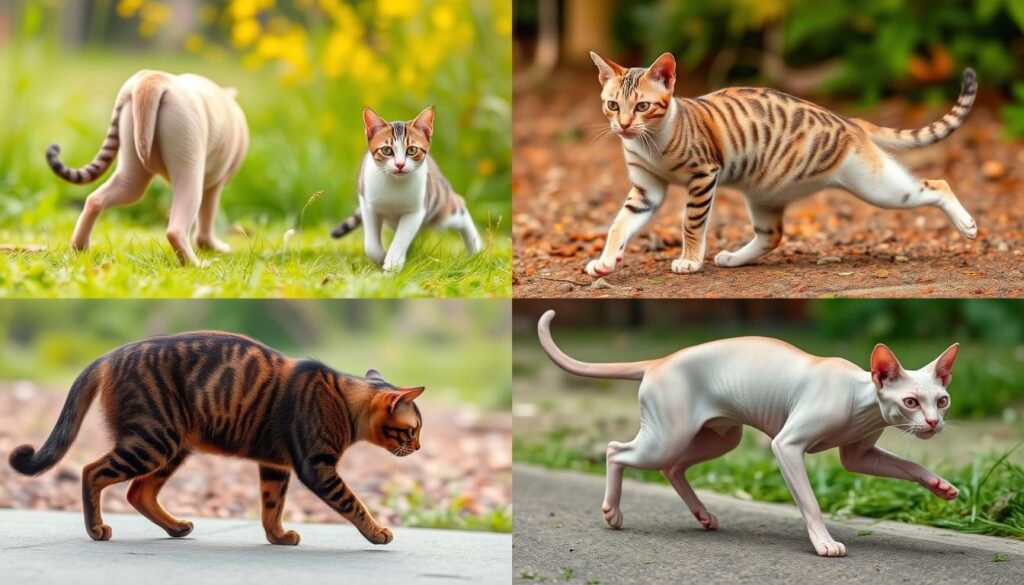
Cats are amazing creatures with unique cat gaits. These gaits show their incredible ability to move. Understanding how cats move helps us see their advanced movement patterns in various situations.
Cats use several distinct ways to move:
- Walking gait: Slow, deliberate movement used for normal exploration
- Trotting: Faster movement with diagonal leg coordination
- Galloping: High-speed sprint for rapid escapes or hunting
- Jumping: Vertical movement demonstrating exceptional muscle control
- Swimming: Specialized aquatic movement for water-based environments
Each movement pattern has its own purpose. The walking gait helps cats move quietly and precisely. Galloping, on the other hand, allows for quick responses when hunting.
*Cats move with an elegant precision that transforms ordinary movement into an art form.*
| Gait Type | Speed | Primary Purpose |
|---|---|---|
| Walking | Slow | Exploration |
| Trotting | Medium | Regular Travel |
| Galloping | Fast | Hunting/Escape |
| Jumping | Vertical | Obstacle Navigation |
Your cat’s ability to switch between these gaits shows their amazing athleticism and adaptability.
The Famous “Catwalk” Explained
Cats have a unique walking style that amazes both animal lovers and scientists. Their catwalk gait is a perfect example of feline precision walking. It makes them stand out from other animals.
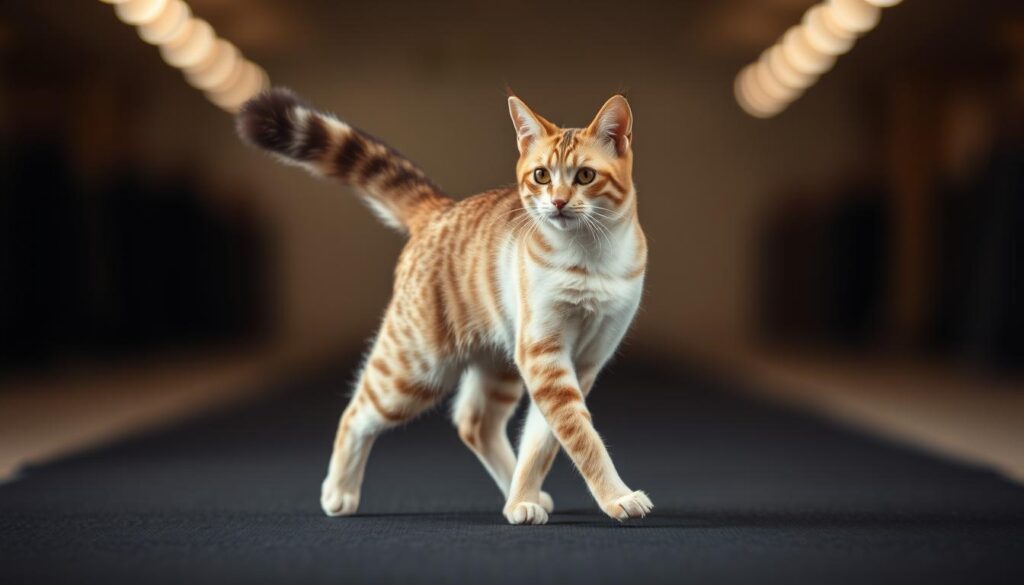
Watching a cat move is truly amazing. They can walk through spaces with incredible grace. Their single line movement shows off their amazing balance and coordination.
Understanding the Single Line Movement
The way cats walk is special. They put each paw right in front of the last one, making a straight line. This walking style has many benefits:
- It helps them move quietly
- It makes less noise
- It helps them stay balanced
- It saves energy
Model-Like Precision in Motion
Cats walk so precisely, it inspired the term “catwalk” in human fashion. Their walk is like a model’s, elegant and controlled.
“A cat’s walk is poetry in motion, each step a deliberate and graceful expression of natural athleticism.” – Veterinary Movement Specialist
| Walking Characteristic | Feline Performance |
|---|---|
| Paw Placement Accuracy | Near-perfect alignment |
| Energy Efficiency | Extremely high |
| Balance Maintenance | Exceptional |
This walking technique shows why cats are so agile and graceful. They are truly amazing creatures.
Walking Your Cat on a Leash: Benefits and Challenges

Cat leash training lets your cat explore the outdoors. Not all cats take to it right away, but many can learn to enjoy it. With the right approach and patience, they can have safe outdoor adventures.
Walking your cat has more than just physical benefits. It also keeps their mind sharp and satisfies their curiosity. They get to see new things, hear different sounds, and smell new smells, making their indoor life more interesting.
- Mental stimulation through environmental enrichment
- Safe controlled outdoor experiences
- Physical exercise and weight management
- Bonding opportunity with your cat
Exploring the outdoors with your cat can be tricky. Some cats might get stressed or feel overwhelmed. It’s important to start slow and watch for any signs of stress or discomfort.
“Patience is key when introducing your cat to leash walking. Every cat has a unique personality and comfort level.” – Veterinary Behaviorist
| Potential Benefits | Potential Challenges |
|---|---|
| Mental stimulation | Potential stress |
| Physical exercise | Environmental risks |
| Sensory exploration | Unpredictable cat reactions |
Understanding your cat’s personality and comfort level is key to successful leash training. Begin with small steps, use positive rewards, and always put your cat’s safety and happiness first.
Essential Equipment for Walking Your Cat
Walking your cat needs special gear for safety and comfort. The right equipment makes outdoor walks safe and fun for you and your cat.
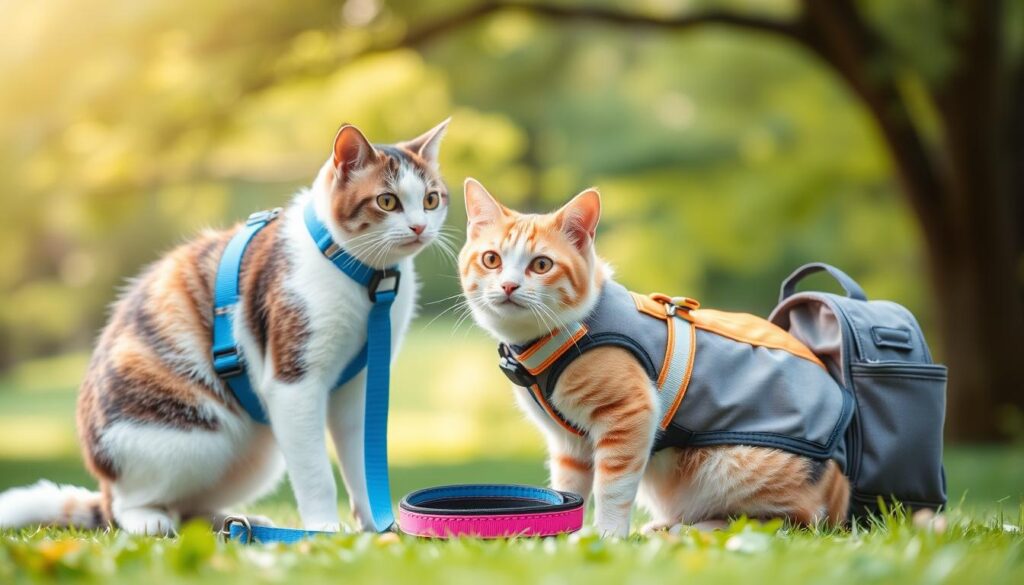
Choosing the Right Cat Harness
A cat harness is key for safety during walks. Look for these features when picking a harness:
- Adjustable straps for a perfect fit
- Breathable material for comfort
- Secure buckles that prevent slipping
- Lightweight design for easy movement
Cat Leash Selection Guide
The right cat leash is important for a good walk. Choose leashes that are light, durable, and let your cat move freely.
- Retractable leashes with lock mechanism
- 4-6 feet length for optimal control
- Reflective materials for visibility
Essential Safety Accessories
There’s more to cat safety than just a harness and leash. Add these items for extra protection:
- Reflective vest for nighttime walks
- ID tags with contact information
- Portable water bottle and collapsible bowl
- Small first-aid kit
“Proper equipment transforms walking your cat from a challenge to an adventure.” – Feline Walking Experts
Quality cat walking equipment makes walks safe, comfy, and fun for you and your cat.
Common Walking Problems in Cats
Cat walking issues can be subtle or dramatic, signaling potential health concerns that demand your attention. Understanding feline gait problems helps you recognize when your cat might need veterinary care.
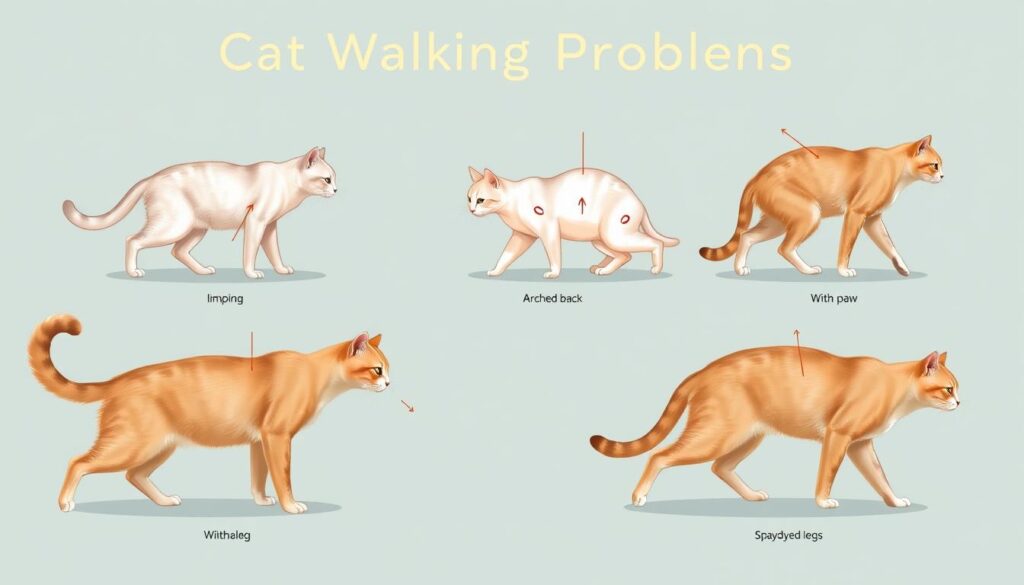
Cats experiencing walking difficulties may display several distinctive symptoms:
- Persistent cat limping
- Uncoordinated movements
- Reluctance to bear weight on specific legs
- Sudden changes in walking patterns
Some common feline gait problems include:
- Limping: Can indicate injuries, arthritis, or muscle strain
- Ataxia: Resembles “drunk walking” suggesting neurological issues
- Paralysis: Potential sign of serious medical conditions
“A cat’s walk reveals more about their health than you might realize.” – Veterinary Orthopedic Specialist
| Walking Issue | Potential Causes | Recommended Action |
|---|---|---|
| Limping | Injury, Joint Disease | Veterinary Examination |
| Unsteady Gait | Neurological Disorders | Neurological Assessment |
| Sudden Paralysis | Arterial Blockage | Immediate Medical Intervention |
Always consult a veterinarian if you notice persistent walking abnormalities in your cat. Early detection can prevent more serious complications and ensure your feline friend’s continued health and mobility.
Signs of Healthy Cat Movement
It’s important to know how your cat moves to check their health. A healthy cat moves smoothly and gracefully. This shows they are agile and in good shape.
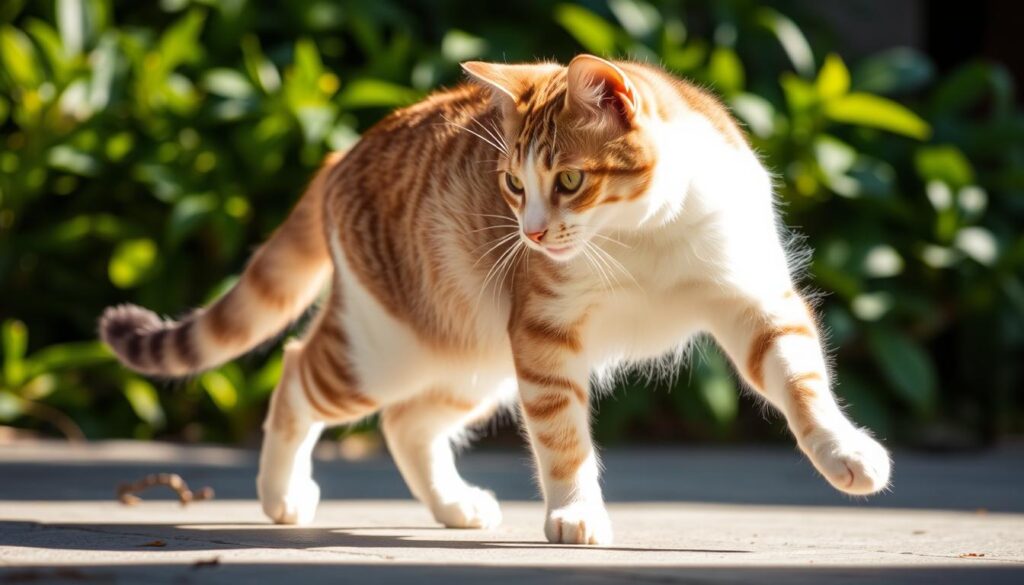
Normal Gait Patterns
A cat’s normal gait has some key features:
- Smooth, fluid walking motion
- Silent and precise step placement
- Even weight distribution across all four legs
- Effortless jumping and landing
Movement Red Flags
Spotting movement problems early can stop serious health issues. Look out for these signs:
- Persistent limping or favoring a specific leg
- Dragging rear legs
- Unsteady walking or loss of balance
- Reluctance to move or jump
| Movement Characteristic | Healthy Indicator | Potential Concern |
|---|---|---|
| Leg Coordination | Synchronized, smooth movement | Irregular or jerky motions |
| Paw Placement | Precise and deliberate | Uncertain or unstable stepping |
| Overall Mobility | Effortless and confident | Hesitation or visible discomfort |
If your cat’s gait seems off, see a vet right away. Catching movement problems early can avoid long-term health issues.
“A cat’s movement tells a story of their physical and emotional well-being.” – Veterinary Movement Specialist
Training Your Cat to Walk on a Leash
Cat Walking : Cat leash training needs patience and a smart plan. It’s different from training dogs because cats are more independent. You must find a way that works for them.
Begin training your cat indoors, where they feel safe. Introduce the harness slowly. Let them get used to it at their own pace.
- Choose a lightweight, comfortable harness
- Let your cat sniff and investigate the harness
- Use positive reinforcement with treats
- Practice short indoor sessions
When starting, make sure the area is calm. Give treats and gentle praise. Don’t push your cat to wear the harness or walk if they’re stressed.
“Patience is key in teaching cats to walk on a leash. Let them set the pace and comfort level.” – Feline Behavior Experts
For outdoor training, pick quiet, safe spots. Start with short walks, 5-10 minutes. Watch your cat’s body language closely. Some cats get used to it fast, while others need more time.
| Training Stage | Duration | Key Focus |
|---|---|---|
| Indoor Harness Introduction | 1-2 weeks | Comfort and Familiarity |
| Indoor Leash Attachment | 3-5 days | Movement Adjustment |
| First Outdoor Sessions | 10-15 minutes | Environmental Exposure |
Not all cats will love walking on a leash. It’s important to respect their unique personality and preferences during training.
Health Benefits of Regular Cat Walking
Walking your cat is more than just a fun activity. It’s a way to boost your cat’s health. Cat exercise benefits are wide-ranging, improving both physical and mental health.
Regular walks can greatly improve your cat’s life. Studies show that physical activity is key to a cat’s well-being.
Physical Exercise Advantages
Cat Walking : Walking helps keep your cat at a healthy weight and muscle tone. It prevents obesity by:
- Burning extra calories
- Building muscle strength
- Improving heart health
- Boosting metabolism
Mental Stimulation Benefits
Walking your cat is more than just a walk. It’s a chance for them to explore and learn. Outdoor walks meet their natural curiosity.
“Walking your cat isn’t just exercise—it’s an adventure that stimulates their mind and body.” – Veterinary Wellness Magazine
The mental perks of walking include:
- Lowering stress and boredom
- Reducing bad behavior
- Boosting brain function
- Offering new sights and smells
Remember, every cat is different. Start slow and watch how they react to walks. This way, you can enjoy the amazing health benefits together.
When to Consult a Vet About Walking Issues
Spotting cat walking problems early can stop serious health issues. Your cat’s ability to move is key to their happiness. Some walking problems need a vet visit right away to keep your cat healthy and happy.
Some feline gait issues mean your cat might have a medical problem. Look out for these signs that mean it’s time to see a vet:
- Persistent limping lasting more than 24 hours
- Sudden changes in walking pattern
- Reluctance to move or jump
- Visible signs of pain during movement
- Unexpected weakness in hind legs
Emergency situations demand immediate veterinary intervention. Sudden paralysis, especially in hindlegs, needs quick medical help. Cats can’t tell us when they’re in pain, so watching for changes in how they walk is important.
“Early detection of mobility issues can significantly improve treatment outcomes for cats.” – Veterinary Mobility Expert
Other signs that mean you should see a vet include:
- Difficulty using the litter box
- Unexplained reduction in activity levels
- Consistent abnormal walking patterns
- Visible discomfort during movement
Your vet can do a full check-up to find out what’s wrong and suggest the best treatment.
| Walking Issue | Potential Cause | Recommended Action |
|---|---|---|
| Limping | Injury or Joint Problem | Immediate Veterinary Examination |
| Hindleg Weakness | Neurological Condition | Emergency Consultation |
| Reluctant Movement | Pain or Arthritis | Comprehensive Health Assessment |
Getting your cat to the vet early can help fix walking problems and keep your cat happy.
Indoor vs Outdoor Walking Considerations
Choosing between indoor and outdoor walking for your cat is important. Each option has its own benefits and challenges. It depends on your cat’s needs and personality.
Indoor walking is safe and controlled. It keeps your cat away from dangers like predators and traffic. It also helps manage the weather.
- Controlled temperature and climate
- Reduced exposure to parasites
- Minimal risk of getting lost
- Predictable walking surfaces
Outdoor walking lets cats experience new things. They can feel different textures, smell new scents, and use their hunting skills. These experiences are great for their mind and body.
“Every cat is an individual. What works for one might not work for another.” – Veterinary Behavioral Expert
When picking between indoor and outdoor walking, think about your cat’s:
- Temperament
- Health status
- Previous outdoor experiences
- Local environmental conditions
The best choice balances your cat’s needs with safety and comfort. Talk to your vet to find the right walking plan for your cat.
Safety Tips for Walking Your Cat Outdoors
Walking your cat outside can be fun, but it needs careful planning. You must prepare to keep your cat safe and happy.
Before you go outside, remember these important steps to keep your cat safe:
- Always use a secure, well-fitted harness
- Ensure your cat is microchipped and wearing ID tags
- Choose quiet walking areas away from heavy traffic
- Avoid peak times with high dog walker activity
Environmental Awareness
Safe exploration starts with knowing potential dangers. Look out for:
- Toxic plants in your walking area
- Potential wildlife encounters
- Unfriendly neighborhood animals
- Sudden loud noises that might startle your cat
Weather Considerations
Weather and temperature are key to keeping your cat safe. Here’s how to protect them:
| Temperature Range | Precautions |
|---|---|
| Hot Weather (85°F+) | Limit walk duration, bring water, avoid midday heat |
| Cold Weather (Below 45°F) | Consider cat jacket, limit outdoor time, watch for shivering |
| Rainy/Windy Conditions | Skip walks, protect from moisture and wind chill |
“Preparation is the key to safe and enjoyable cat walking adventures.” – Veterinary Outdoor Pet Safety Guide
Always put your cat’s comfort and safety first when exploring outdoors.
Alternative Exercise Options for Cats
When outdoor walks aren’t possible, cat owners can explore many indoor activities. These keep their felines active and engaged. Feline enrichment is more than just playtime. It’s essential for your cat’s mental and physical health.
Interactive toys are great for cat exercise indoors. They mimic natural hunting behaviors. Here are some fun options:
- Puzzle feeders that challenge your cat’s problem-solving skills
- Climbing structures with multiple levels
- Electronic motion toys that trigger hunting instincts
- Laser pointer games for cardiovascular exercise
Make an indoor obstacle course with items like cardboard boxes and tunnels. These setups encourage movement and exploration. They also prevent boredom.
“Cats need mental and physical stimulation to maintain their health and happiness.” – Veterinary Behavior Specialists
For cats with limited space, vertical enrichment is a good option. Cat shelves, window perches, and wall-mounted climbing paths make indoor spaces exciting. They offer safe alternatives to outdoor walks and satisfy your cat’s curiosity.
Remember, regular, interactive play is crucial. It keeps your cat physically fit and mentally well. Change toys often to keep playtime interesting.
Conclusion
Understanding how cats walk is key to keeping them healthy. Cat walking does more than just get them moving. It’s important for their mind and body.
By knowing how cats move and their possible health issues, you can care for them better. Try different ways to walk your cat, like using a leash or playing indoors. The most important thing is to keep them active and watch what they like and can do.
Vets say to make exercise plans that fit your cat’s needs. Regular activity keeps them fit and happy. By learning about your cat’s walking habits and giving them the right activities, you’ll make them a happier, healthier friend.
Every cat is different, so what works for one might not work for another. Be patient, watch your cat closely, and always put their comfort and safety first.

